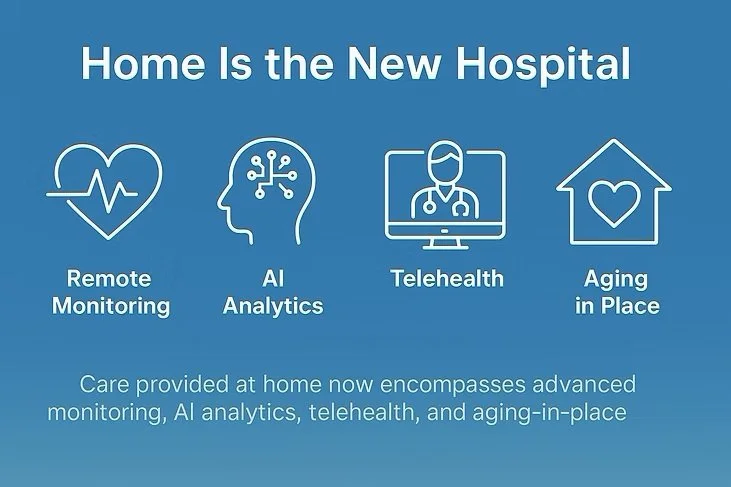Home Is the New Hospital: How Virtual Acute Care and AI Are Reshaping Healthcare in 2025
Care provided at home now encompasses advanced monitoring, AI analytics, telehealth and aging-in-place. (Source: ChatGPT)
In 2025, the healthcare landscape is undergoing a significant transformation, with virtual acute care and hospital-at-home (HaH) models becoming integral components of patient care. Driven by technological advancements, policy adaptations, and shifting patient expectations, these models are redefining how and where acute care is delivered.
Policy Evolution: Catalyzing the Shift to Home-Based Acute Care
Government policies have been pivotal in accelerating the adoption of virtual acute care. In the United States, the Centers for Medicare & Medicaid Services (CMS) has approved 378 hospitals across 140 systems in 39 states for waivers to be reimbursed for HaH care models as of late November 2024. These waivers, extended through March 2025, have enabled hospitals to deliver acute care services in patients' homes, addressing hospital capacity challenges and patient preferences for home-based care.
Source: Healthcare IT Today+2Becker's Hospital Review+2Becker's Hospital Review+2
Similarly, international initiatives like Saudi Arabia's Seha Virtual Hospital, recognized as the world's largest virtual hospital, demonstrate the global momentum towards virtual care models. Seha coordinates with 224 hospitals, offering 44 specialized services, and exemplifies how virtual hospitals can enhance access to care, especially in remote regions.
Source: Financial Times
Technological Advancements: Enabling Effective Home-Based Care
The integration of artificial intelligence (AI) and remote patient monitoring (RPM) technologies has been instrumental in the success of virtual acute care. AI-driven solutions facilitate real-time monitoring, predictive analytics, and enhanced communication between patients and providers. According to the 2025 Care at Home Industry Trends Report, AI is identified as the top emerging trend, with providers recognizing its potential to transform healthcare operations by 2030.
Source: PR Newswire
Wearable devices and telehealth platforms have also become essential tools, allowing continuous monitoring of patients' vital signs and enabling timely interventions. These technologies not only improve patient outcomes but also alleviate the burden on healthcare facilities by reducing unnecessary hospital admissions.
Market Dynamics: Opportunities and Challenges
The shift towards home-based acute care presents significant market opportunities. McKinsey & Company estimates that up to $265 billion worth of care services, representing up to 25% of the total cost of care for Medicare fee-for-service and Medicare Advantage beneficiaries, could transition from traditional facilities to home settings by 2025 without compromising quality or access.
Source: American Hospital Association+1McKinsey & Company+1
However, challenges persist. Reimbursement uncertainties, infrastructure requirements, and the need for standardized protocols pose obstacles to widespread adoption. Moreover, ensuring data privacy and compliance with regulations like HIPAA remains a critical concern as virtual care models expand.
Implications for the Elder Care and Long-Term Care Industry
The evolution of virtual acute care has profound implications for the elder care and long-term care sectors. By enabling acute care delivery in home settings, these models support aging-in-place strategies, enhance patient comfort, and reduce the reliance on institutional care facilities. Furthermore, the integration of AI and RPM technologies can lead to more personalized and proactive care for older adults, addressing chronic conditions more effectively and improving overall quality of life.
Source: wired.com
🚀 Connect with Global Leaders in Ageing & Care Innovation!
Sourcingcares links international partners in aging care, long-term care, and health technology, fostering collaboration and driving solutions for a changing world. Our initiatives include Cares Expo Taipei—where the future of elder care takes shape!
🔗 Follow us for insights & opportunities:
📌 Facebook: sourcingcares
📌 LinkedIn: sourcingcares
📍 Explore more at Cares Expo Taipei!

